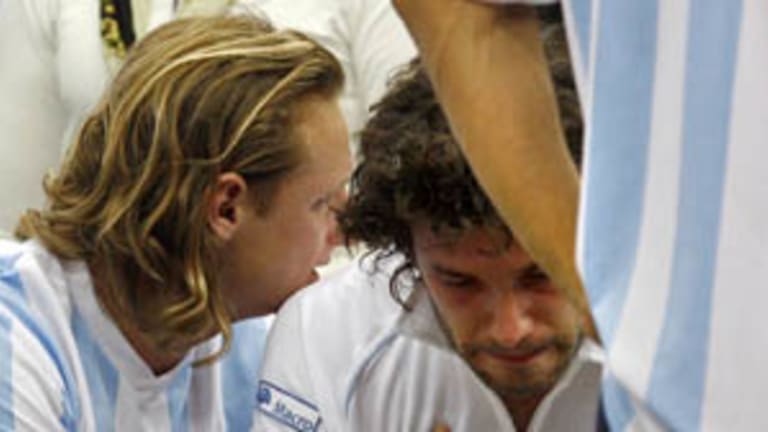David Nalbandian, age 31, ranked 231, announced his retirement today. What will you remember most from his 13-year career? For a player who never reached No. 1 or won a major title, he offered us a lot—some of it was glorious, some notorious.
On the plus side, there were his Grand Slam successes, which included a run to the Wimbledon final in 2002, and subsequent semifinal appearances at each of the other three majors. There was his biggest title, the 2005 Masters Cup. There was his stellar Davis Cup record; a devotee of the team event, he went 23-6 in singles and led Argentina to the final three times. There was also his ability, rare among the men today, to hang with the elite. Nalbandian, a junior rival of Roger Federer’s, beat him eight times as a pro, and recorded 13 wins over the Big 4 in total. He had that kind of talent, and he was an all-surface threat.
On the minus side, there was Nalbandian’s unfortunate signature YouTube moment, perhaps the most infamous swift kick in the game's history. During the Queen’s Club final in 2012, he booted and destroyed a wooden box in front of a linesman. It left the guy with a chunk of lumber in his leg, and left Nalbandian disqualified. As far as Nalby’s talent went, yes, he had it, but no, he never made the most of it. He reached match point against Andy Roddick in the U.S. Open semifinals in 2003. Three years later, he was up 4-2 in the fifth set against Marcos Baghdatis in the semifinals of the Australian Open. Both times he was on the brink; both times he lost. He'll go down as one of the best players never to win a major.
At the end of 2007, Nalbandian showed the world exactly how good he could be by tearing through that season’s last two Masters events. In Madrid, he beat Nadal, Djokovic, and Federer in succession for the title. Two weeks later at Bercy, he beat Federer and Nadal in straight sets, again for the title, and bageled Rafa in the second set for good measure (see the highlights of that match above). Going into 2008, naturally, expectations for Nalbandian were sky high. How did he respond? He failed to get out of the third round at any of the Grand Slams that year. While he was certainly injury prone, few would disagree that Nalby, who sported a permanent spare tire and seemed as passionate about rally-car racing as he was about tennis, was an underachiever. It wasn’t for nothing that he was handed one of tennis’s more memorable, and less flattering, nicknames: Fat Dave.
Still, whether he won or lost, played brilliantly or squandered his chances, I was always a Nalbandian fan. For me, what stands out about him is this: He was the one of the very few players with a two-handed backhand who became a cult figure among the game’s style cognoscenti. Normally, beauty in tennis is thought to come from the one-hander. Ken Rosewall, Evonne Goolagong, Justine Henin, Richard Gasquet, Grigor Dimitrov: Fans typically sing the praises of the flowing single-handed backhand. David Nalbandian could make us do it with two. His backhand—easy, silky, varied, lethal—was my favorite two-hander to watch. But that wasn’t the only appealing aspect of his game. Nalbandian was smooth all around, his forehand was a paragon of balance, and he could volley; he was as fun to watch on a doubles court as he was in singles. He may never have been in tip-top shape, but when he was clicking, he didn’t need to be. Often, he seemed to simply materialize at the ball, perfectly positioned for the next shot. When Nalbandian had time to set up, few struck the ball as cleanly or carved up the court as clinically. (Nalby also, in his spare time, wasn't afraid to sing. See him try it, with epic results, here.)
